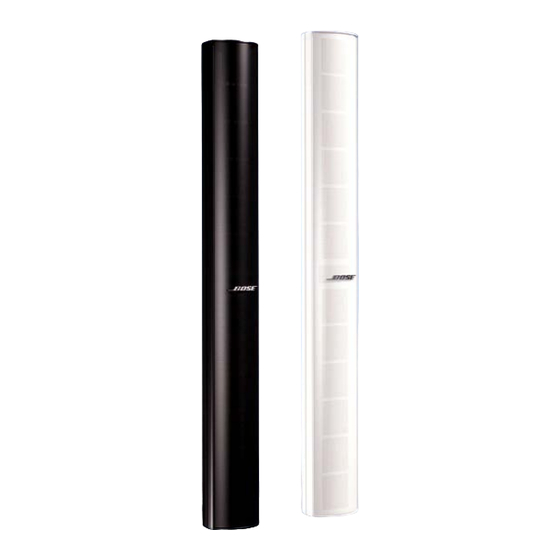Bose Panaray MA12 Technical Foundation & Discussion - Page 20
Browse online or download pdf Technical Foundation & Discussion for Speakers Bose Panaray MA12. Bose Panaray MA12 36 pages. Modular line array loudspeaker
Also for Bose Panaray MA12: User Manual (2 pages), Installation Manual (16 pages), Installation Manual (8 pages), Installation Manual (7 pages), Service Manual (11 pages)

APPLYING LINE SOURCES TO SOUND SYSTEM DESIGN
T
3 dB per doubling behavior of cylindrical waves is of special interest in sound system
HE
design because it is so much more gradual than the 6 dB per doubling behavior that
motivated us to hang and tilt speakers. On the other hand, so was the 0 dB per doubling
behavior of plane waves, but unfortunately, producing them was impractical in real life. Is it
more practical to produce cylindrical waves? Or are there problems that will rule this out too?
If such a source can be realized, would it really do a good job at meeting customer
requirements?
Source shape and sound output capability
T
begin, a source that produces cylindrical waves does not have to be rejected for the same
O
reasons a plane-wave source was rejected. A cylindrical-wave source must be as tall as the
audience, but not as wide, since the wide horizontal radiation pattern can be relied on to
cover an audience distributed side to side; a tall, slim source, resulting in wide side-to-side
radiation, can cover a typical audience.
Second, with modern transducer technology, there is no reason that a line source can not
produce a balanced frequency response at the kind of output levels required in many
applications. Major improvements in transducer technology (including many introduced by
Bose) mean that it is no longer true that the small transducers needed to fit into a slim line-
shaped source lack the correct balance of frequencies or necessary output capacity. A full,
balanced frequency response and very high output is now possible from speakers no larger
that a tea cup. Therefore, concerns about frequency response and output are also not reasons
to reject the line source.
Meeting the primary customer requirements
I
principal – in other words without regard to the specifics of any particular implementation
N
– would a line-shaped source radiating cylindrical or near-cylindrical waves be a good choice
for meeting the major customer requirements listed earlier?
Re-examination of the side view of the radiation pattern of a line source, shown in Figure
11, reveals that sound does not radiate up and down, but rather is confined to a region
between a plane perpendicular to the top of the array and one perpendicular to the bottom.
When such a source is placed in a room, it means that sound will not radiate up and down and
therefore will not radiate to the ceiling and upper walls, where reflections contribute to the
amount of reverberation and therefore to the degradation of music clarity and speech
intelligibility. Such a source would be therefore ideally suited to environments with longer
reverberation times such as churches, auditoriums, airports, hallways and so on.
®
Bose
MA12™ Modular Array: Technical Foundation & Discussion
April 2002, © Bose Corporation, All Rights Reserved
Page 20 of 36
